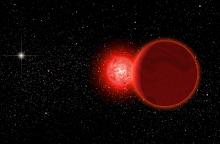Listen to today's episode of StarDate on the web the same day it airs in high-quality streaming audio without any extra ads or announcements. Choose a $8 one-month pass, or listen every day for a year for just $30.
You are here
Vega
Vega, one of the brightest stars of summer nights, stands high in the east as darkness falls this evening. It’s the brightest member of the Summer Triangle, a wide pattern that’s easy to pick out even through the murky skies of a city.
Vega looks so bright in part because it’s only 25 light-years away. In other words, the light we see from the star tonight actually began its journey across the galaxy 25 years ago. By astronomical standards, that’s just down the street. Even so, if you want to go to Vega, be sure to stock up on snacks — it’ll be a long trip.
Traveling at highway speeds of 70 miles per hour, it would take about 250 million years to get there. Change highway speeds to airline speeds, and you’re still talking 30 million years. And even at the speed of the fastest spacecraft ever launched from Earth, you wouldn’t get to Vega for 400 thousand years.
Once you got to Vega, though, you’d have an interesting view. From Earth, we’re looking almost straight down at one of the star’s poles. A broad disk of gas and dust encircles Vega — a disk that may contain icy comets, rocky asteroids, and perhaps even some planets.
The disk is quite faint compared to the star. But from the inside of a rocketship, with no atmosphere between you and the system, you could simply block out Vega’s light with your hand. This mini-eclipse would let you see the spread-out disk, glowing faintly in the light of brilliant Vega.
Script by Damond Benningfield





